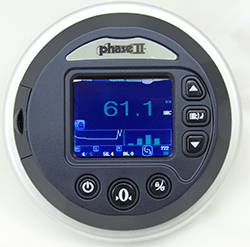Description
Rockwell Hardness Tester Model No. 900-331D
This rockwell hardness tester combines our best selling 900‐331 hardness tester model with our new 9700 series rockwell hardness digital indicator upgrade. This brilliant combination gives you the very best functions of a digital rockwell hardness tester yet has the ease of use of our analog machines. Conforming to ASTM E‐18 Rockwell Hardness standards, the 900‐331D hardness tester will offer unmatched repeatability in all standard Rockwell Hardness scales (table shown below). A perfect, rugged performer suited for any environment including heat treat facilities, tool rooms, workshops, laboratories and inspection labs. Lifetime technical support is included on all Phase II Hardness Testers. So test away with confidence and a level of accuracy you will only find at Phase II.
| Rockwell Hardness Tester Features: | - Direct Digital Reading
- Automatic conversions to Brinell, Vickers, etc.
- Advanced design, easy to operate
- Engineered to obtain highly sensitive and accurate readings
- Conforms to ASTM E‐18
- Perfect for laboratories, workshops, tool rooms, inspection labs, etc.
|
| Hardness Tester Accessories: | - C‐scale Diamond Indentor
- 1/16” Ball Indentor
- 3‐ HRC Test Blocks
- 1‐ HRB Test Block
- Test Table 5.87” (150mm)
- Flat Anvil 2.5” (63mm)
- Spot Anvil .38: (10mm)
- Std. Vee Anvil
- Accessory Case
- Dust Cover
|

| Minor Load | 10Kgf |
| Major Load | 60Kgf, 100Kgf, 150Kgf |
| Test Force Application | Dead Weight |
| Test Force Control | Hydraulic Dashpot System |
| Results Display | Digital Gage |
| Vertical Capacity | 6.7 in. |
| Throat Depth | 6.6 in. |
| Height | 30.0 in. |
| Width | 8.50 in. |
| Depth | 20.0 in. |
| Shipping Weight | 242 lbs. |
| Scale Symbol | Indenter Type Ball dimensions indicate diameter | Preliminary Force N (kgf) | Total Force N (kgf) | Typical Application |
| A | Spheroconical Diamond | 98.07 (10) | 588.4 (60) | Cemented carbides, thin steel and shallow case hardened steel |
| B | Ball 1/16” (1.588mm) | 98.07 (10) | 980.7 (100) | Copper alloys, soft steels, alum. Alloys, malleable iron, etc. |
| C | Spheroconical Diamond | 98.07 (10) | 1471 (150) | Steel, hard cast irons,pearltic malleable iron, titanium, deep case hardened steel & other material harder than HRB 100 |
| D | Spheroconical Diamond | 98.07 (10) | 980.7 (100 | Thin steel and medium case hardened steel and pearlitic malleable iron |
| E | Ball – 1/8” (3.175mm) | 98.07 (10) | 980.7 (100) | Cast iron, aluminum&magnesium alloys and bearing metals |
| F | Ball – 1/16” (1.588mm) | 98.07 (10) | 588.4 (60) | Annealed copper alloys, and thin soft sheet metals |
| G | Ball – 1/16” (1.588mm) | 98.07 (10) | 1471 (150) | Malleable irons, copper-nckel-zinc and cupronickel alloys |
| H | Ball – 1/8” (3.175mm) | 98.07 (10) | 588.4 (60) | Bearing metals and other very soft or thin materials. Use smallest ball and heaviest load that does not give anvil effect |
| K | Ball – 1/8” (3.175mm) | 98.07 (10) | 1471 (150) |
| L | Ball – ¼” (6.350mm) | 98.07 (10) | 588.4 (60) |
| M | Ball – ¼” (6.350mm) | 98.07 (10) | 980.7 (100) |
| P | Ball – ¼” (12.70mm) | 98.07 (10) | 1471 (150) |
| R | Ball – ½” (12.70mm) | 98.07 (10) | 588.4 (60) |
| S | Ball – ½” (12.70mm) | 98.07 (10) | 980.7 (100) |
| V | Ball – ½” (12.70mm) | 98.07 (10) | 1471 (150) | |
Principle of Rockwell hardness testing The Rockwell hardness test is one of several common indentation hardness tests used today, other examples being the Brinell hardness test and Vickers hardness test. Most indentation hardness tests are a measure of the deformation that occurs when the material under test is penetrated with a specific type of indenter . In the case of the Rockwell hardness test, two levels of force are applied to the indenter at specified rates and with specific dwell times. Unlike the Brinell and Vickers tests, where the size of the indentation is measured following the indentation process, the Rockwell hardness of the material is based on the difference in the depth of the indenter at two specific times during the testing cycle. The value of hardness is calculated using a formula that was derived to yield a number falling within an arbitrarily defined range of numbers known as a Rockwell hardness scale. The general Rockwell hardness test procedure is the same regardless of the Rockwell scale or indenter being used. The indenter is brought into contact with the material to be tested, and a preliminary force (formally referred to as the minor load) is applied to the indenter. The preliminary force is usually held constant for a set period of time (dwell time), after which the depth of indentation is measured. After the measurement is made, an additional amount of force is applied at a set rate to increase the applied force to the total force level (formally referred to as the major load). The total force is held constant for a set time period, after which the additional force is removed, returning to the preliminary force level. After holding the preliminary force constant for a set time period, the depth of indentation is measured a second time, followed by the removal of the indenter from the test material. The measured difference between the first and second indentation depth measurements, “h”, is then used to calculate the Rockwell hardness number. For many older models of Rockwell hardness machines , the operator must manually control most or all of the steps of the test procedure. Many of today’s newer machines automatically perform the entire Rockwell hardness test.

